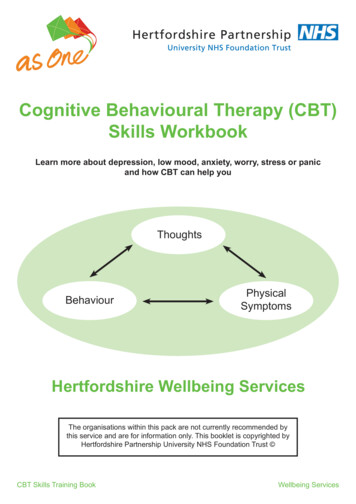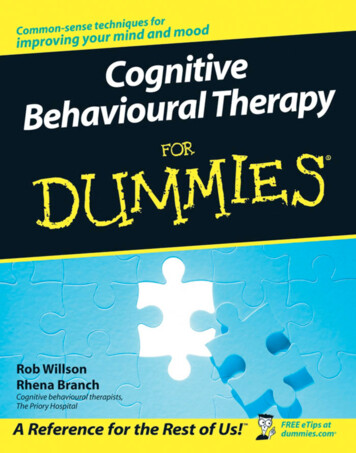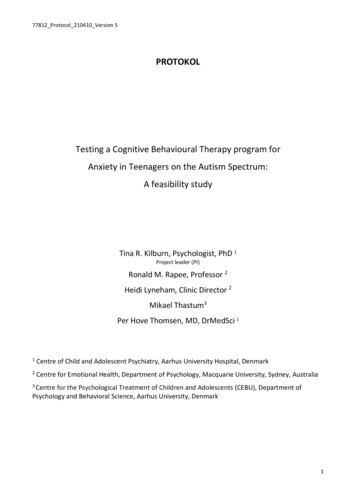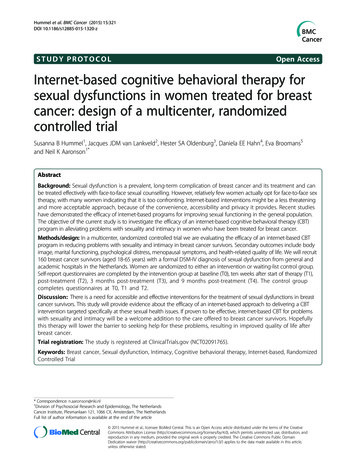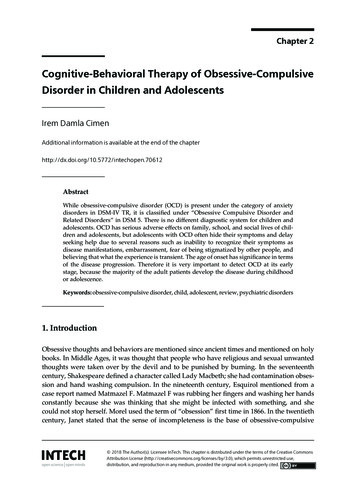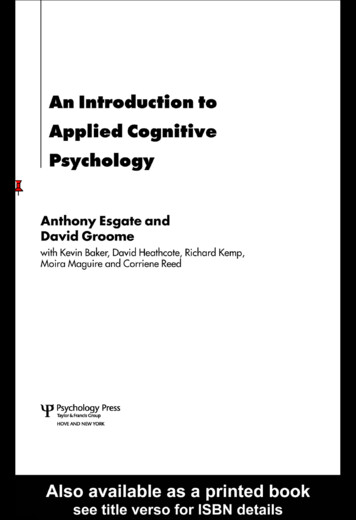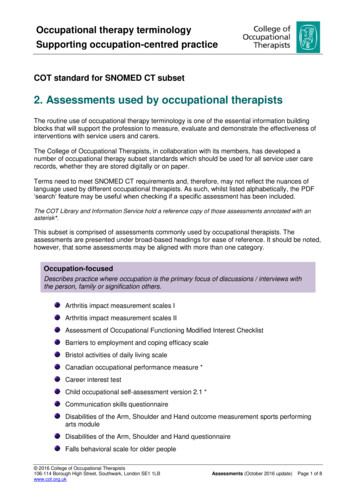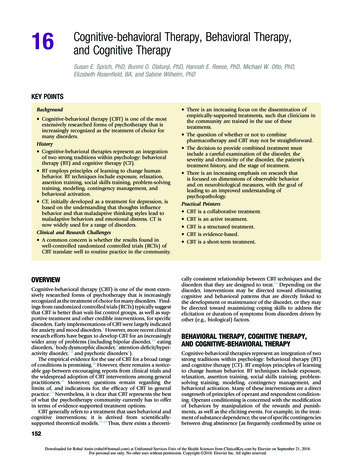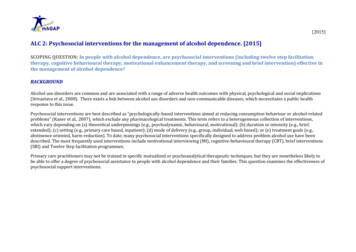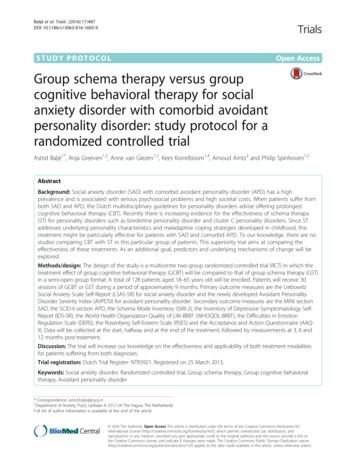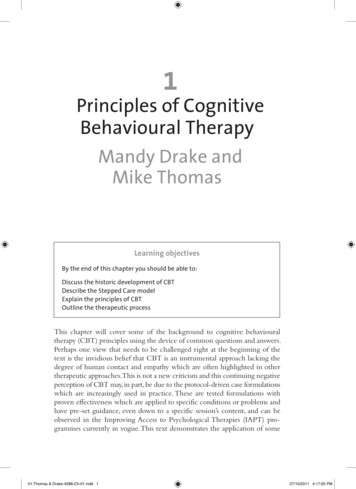
Transcription
1Principles of CognitiveBehavioural TherapyMandy Drake andMike ThomasLearning objectivesBy the end of this chapter you should be able to:Discuss the historic development of CBTDescribe the Stepped Care modelExplain the principles of CBTOutline the therapeutic processThis chapter will cover some of the background to cognitive behaviouraltherapy (CBT) principles using the device of common questions and answers.Perhaps one view that needs to be challenged right at the beginning of thetext is the invidious belief that CBT is an instrumental approach lacking thedegree of human contact and empathy which are often highlighted in othertherapeutic approaches.This is not a new criticism and this continuing negativeperception of CBT may, in part, be due to the protocol-driven case formulationswhich are increasingly used in practice. These are tested formulations withproven effectiveness which are applied to specific conditions or problems andhave pre-set guidance, even down to a specific session’s content, and can beobserved in the Improving Access to Psychological Therapies (IAPT) programmes currently in vogue. This text demonstrates the application of some01-Thomas & Drake-4286-Ch-01.indd 127/10/2011 4:17:05 PM
2C o g n i t i v e B e h a v i o u r T h e r a p y C a se S t u d i esprotocol-driven formulations, particularly when engaging in maintenancetherapy, but we have also attempted to present generic and idiosyncratic caseformulations (idiosyncratic referring to bespoke and more appropriate formulations based on clients’ multi-problem or complex presentations).CBT exponents have had to constantly emphasise the compassionate andhumanistic elements of the therapy. As far back as 1989, Gelder noted thatCBT was concerned with the thoughts and feelings of the individual and wastherefore an important bridge between the then more dominant behaviouralapproaches and the dynamic therapies. In 1995 Judith Beck emphasised theempathetic skills required of the CBT practitioner and the need for themto be authentic and genuine in their commitment and interest towards theclient as an individual. By 1996 Salkovskis had argued against the mechanical application of CBT whilst Padesky (1996) had highlighted the need forskilled psychotherapeutic application to prevent a prescriptive approach. Morerecently, Thomas (2008) pointed out that the founder of CBT, Aaron Beck,originated from a psychoanalytical background and that it was his attemptin the late 1950s and early 1960s to bring psychoanalytical principles intobehavioural approaches that first gave him the origins of what became CBT.More recently Westbrook, Kennerley and Kirk (2011) have acknowledged that,despite repeated refutation, CBT still has the reputation of being a mechanicalapplication of techniques and as such they have argued that CBT is in facta therapy of understanding (see below). This approach supports the work ofLeahy (2008), who argues that the therapist who demonstrates understanding of the clients’ suffering increases the chances of a successful therapeuticoutcome.This book continues to argue that CBT has a humanistic aspect in thattherapeutic interaction cannot be adequately practised without a good, soundlevel of communication skills, empathy and understanding for, and of, theclient. It also demonstrates that case formulation and assessment require theestablishment of trust and confidence in both the therapy and the therapistand that this cannot occur without sound and skilful interpersonal interaction. In fact one could posit a view that CBT treatment interventions without the necessary understanding and empathy are not actually CBT but anartificial application of CBT principles, often based on an economic modelof cost effectiveness rather than a genuine, authentic interest in the plight ofthose seeking support. That is perhaps where the mechanistic, instrumentalapproach lies; with those practitioners who claim to practise CBT but donot grasp the level of interpersonal techniques and skills required to supportclients through difficulties.This constant drive to retain and highlight the compassionate elementsof CBT as a reaction to those who promote the recipe models may explain01-Thomas & Drake-4286-Ch-01.indd 227/10/2011 4:17:05 PM
P r i n c i p l es o f C o g n i t i v e B e h a v i o u r a l T h e r a p y3the ‘third wave’ of CBT techniques now gaining popularity with moreemphasis on mindfulness-based cognitive therapy, integrated meta-cognitiveapproaches, schema-focused therapy and the assimilation of brief, group andfamily therapy techniques into CBT practices.One of the aims of this book is to demonstrate through case studies the reality of practising CBT with clients who have myriad difficulties and who seekcompassion, trust and skilful intervention to support them as they deal with theintricacies of their daily lives. Thus, the reader will not find exemplars here, asclients with simple, single-issue presentations may well be suited to the theoretical application of CBT but unfortunately tend not to exist in the realities ofpractice. Instead we have attempted to demonstrate the application of CBT tocases that are reflective of the real issues found in clinical practice, thus better representing the complex clinical world experienced by many CBT practitioners.Some background reading may be useful, and certainly having access tothe Diagnostic and Statistical Manual of Mental Disorders, 4th edn – Text Revision(DSM-IV-TR; APA, 2000) and the International Statistical Classification ofDiseases and Related Health Problems, 10th Revision (ICD-10; WHO, 2007),would enhance understanding of the diagnostic criteria for each presentedclinical problem. There are also several excellent CBT texts available whichprovide ample background knowledge of theory and principles in more depththan we go into, and it is our assumption that readers will draw on these tocomplement the case-study approach taken here.Yet a text on CBT cannot be presented without some acknowledgementof the principles of CBT and this chapter begins with one of the most common queries.Why CBT?CBT appears to meet three conditions which have helped it to gain popularityas a treatment of choice in many clinical environments and more recentlywithin the wider social world. These include the strong evidence base for itseffectiveness, its cost benefits in terms of resource use, particularly with theadvent of guided self-help, psycho-educational and e-CBT approaches, andits flexibility in application in relation to the number and duration of sessions,the level at which treatment can be aimed and the growing number of conditionsto which it can be applied.Gelder (1989) noted that it was during the 1970s and 1980s that CBTgained popularity, stating that this is when it was found to be more amenableto clinical trials and was thus considered to be more scientific in its approachesthan the other approaches of that era. The range of conditions to which it01-Thomas & Drake-4286-Ch-01.indd 327/10/2011 4:17:05 PM
4C o g n i t i v e B e h a v i o u r T h e r a p y C a se S t u d i escould be applied was demonstrated by Hawton and colleagues (1989), wholisted panic, generalised anxiety, phobias, obsessions, eating disorders, sexualdysfunctions, relationship problems, somatic problems and depression amongthose where CBT was effective.Beck, Freeman and Associates (1990) went on to apply CBT with individualspresenting with personality disorders and not many years later Haddock andSlade (1997) demonstrated CBT to be effective with individuals experiencingpsychosis. Since then Murray and Cartwright-Hatton (2006) have looked atCBT interventions in the field of child and adolescent mental health, Free(2000) has used it in group settings and Crane (2010) has applied it in a mindfulness context. Lazarus (1997) and Curwen, Palmer and Ruddell (2008), haveemphasised its use in a brief therapy setting and Robinson (2009) has observedthat CBT is being incorporated into family therapy interventions. Westbrooket al. (2011) suggests that CBT has increased in popularity over the last 30years because its roots lie in scientific psychology and therefore it has takenan empirical approach which allows practitioners and researchers to providemore evidence for its use more rapidly than other therapies. Alongside suchefficacy studies it has also consistently demonstrated an improved economicmodel compared to other therapies, particularly with its emphasis on 6–12sessions.CBT has been shown to be effective in many evidence-based studies, withreduced negative symptoms for clients and more positive health outcomesand changes in their daily living. For the health economist, the service managersand the politicians this indicates less need for health intervention and thereforeless utilisation of health resources; for as well as demonstrating effectivenessCBT also demonstrates efficiency. This makes it a treatment of choice for theindependent sector, the privately funded single-practitioner therapist and theNHS, particularly if there are time-limited sessions of around 6–12 sessions.Its effectiveness and efficiency has gained CBT the attention of the NationalInstitute of Clinical excellence (NICE) which has produced a series of guidelines specifying CBT as the recommended treatment therapy. CBT thereforemeets government objectives (of whatever political persuasion) of managingpublic funds (Thomas, 2008).CBT also has the flexibility to be included in the Pathways to Care (SteppedCare model) widely implemented in mental health settings in the UnitedKingdom. In this model there are a number of steps representing differentintensities of treatments and interventions. Each step therefore provides anincreasing level of support and the client can be referred out of the Pathwayor upwards or downwards as their condition deteriorates or improves. Clientscan also access a step without necessarily completing lower steps, dependingon their level of need and severity of presenting symptoms.01-Thomas & Drake-4286-Ch-01.indd 427/10/2011 4:17:05 PM
P r i n c i p l es o f C o g n i t i v e B e h a v i o u r a l T h e r a p y5Step 1, Watchful Waiting, is used when clients do not want any healthinterventions or when the practitioner believes that they may recover withoutany interventions, and is generally viewed as a sub-clinical situation. Step 2 isaimed at individuals presenting with mild to moderate conditions and involvesguided self-help, CBT utilising psycho-educational interventions, e-CBT andexercise-on-prescription or sign-posting towards local voluntary or self-helpgroups. Step 3 is for clients presenting with moderate conditions and this iswhere CBT becomes more intensive. The emphasis, however, is on briefertherapies where possible, sometimes coupled with psycho-pharmaceuticalinterventions. Step 4 is for individuals experiencing moderate to severe conditions,involves chronic or severe disorder management and may involve assigning acase manager to work alongside the client. The case manager in turn, usuallysupported by a specialist mental health worker liaises with the client’s generalpractitioner and other significant carers, co-ordinates case conferences, andmaintains contact with the client on a regular basis. Interventions may involvebrief CBT, psycho-pharmaceutical input or longer-term CBT for up to 16to 20 sessions. The final stage of the Care Pathway, step 5, is for clients experiencing chronic, severe or enduring problems, is offered by specialist mentalhealth services and aims to support clients who have failed to improve in theprevious steps or who have such severe problems that those interventions insteps 1–4 are inappropriate. Treatment usually means inpatient care providingcomplex psychological and psycho-pharmaceutical interventions.In summary, CBT has spread widely over the last four decades. It has demonstrated its effectiveness and efficiency in two ways: across different clinicalservices and clinical conditions using evidence-based studies; and in its costeffectiveness in terms of resource allocation. It is therefore recommended byNICE as a treatment intervention in many clinical conditions, and as such hasbecome the most advocated intervention in the Stepped Care model whichis integral to current mental health service delivery.What is the aim of CBT?CBT heralds primarily from the work of Aaron Beck who first publishedin this area in the 1960s and 1970s. It aims to provide a problem-orientatedframework within which a cognitive-behavioural assessment and resultingcase formulation can be conducted and compiled (Hawton et al., 1989).Originally the aims of the assessment and formulation were to provide anindividualised treatment programme for clients presenting with a variety of clinical problems, but CBT has developed so that it is now applied in a variety ofnon-clinical settings, including education, sport, business, politics and the media.01-Thomas & Drake-4286-Ch-01.indd 527/10/2011 4:17:05 PM
6C o g n i t i v e B e h a v i o u r T h e r a p y C a se S t u d i esThis book, however, focuses on its application in the clinical setting. Persons(1989) stated that the aim of therapy was to differentiate between the client’s overt difficulties, in other words the real problems presented by a client,and the underlying psychological mechanisms which underpin or cause theovert problem, often based on irrational beliefs about the self. The therapistshould therefore support the client in exploring the overt problem and therelationship with underlying psychological mechanisms in order to alleviatethe underlying causative factors.However, CBT has never been a ‘school’ of therapy and there are manydifferent philosophical and practical views regarding its theoretical basis andimplementation. As mentioned above, Westbrook, Kennerley and Kirk (2011)suggest that the aim of CBT is to gain understanding: understanding of theclients’ own individual situation and problems and understanding of CBTprinciples, the aim being that the two together would provide the most appropriateclinical treatment. Trower, Casey and Dryden (1996) give a slightly different view by pointing out that CBT teaches clients to recognise their ownmaladaptive thinking and to become aware of those thoughts, feelings andsituations that trigger negative automatic thoughts (NATs). Once this hasbeen accomplished, CBT aims to clarify whether the client actually wantsto change their current problems, which is an interesting perspective andperhaps one that is often forgotten in the ‘rescuing’ principles found in manytherapies. Only when the client wants to change is the next aim of CBTinstigated; namely for the client to learn how to modify maladaptive thoughts.This is reflected in Thomas’s (2008), view which states that CBT is a structuraltherapy which aims to modify dysfunctional thinking, behaviour or assumptions. Therapy is focused on the client learning to recognise their own NATs,and by subsequently identifying the triggers for such thoughts and evaluating their impact on their life the client can then modify their responses, thuspreventing unwelcome symptoms and gaining a better quality of life. Kinsellaand Garland (2008) add that another aim of CBT is to achieve agreed outcomes or goals which will improve the clients’ emotional state, and they propose that decreasing negative thoughts and behaviours should be undertakenwithin a time-limited structure using evidence-based interventions.What are the theoretical bases of CBT?CBT is based on a series of principles starting perhaps with Beck’s CognitiveTriad (1976) which states that an individual may be prone to negative thinking about the self, the world and the future. The model has been elaboratedmany times since his early work, but Beck basically suggested that thinking01-Thomas & Drake-4286-Ch-01.indd 627/10/2011 4:17:05 PM
P r i n c i p l es o f C o g n i t i v e B e h a v i o u r a l T h e r a p y7is underpinned by attitudes (termed assumptions) which are based in earlychildhood experiences and later life events. For many people such assumptions support adaptation to the world around them and motivate activity todevelop and maintain wellness. Everyone has a predisposition to react in certain ways in certain situations and this is based on genetics, environment, earlyupbringing and life events.Some life events can, however, be traumatic or at the very least disappointing and can precipitate negative thinking and lower mood states. Low moodin turn heightens the probability of more negative thinking, which reinforcesthe mood state and in time forms a negative circle which begins to influence day-to-day living. This generalisation of negative thinking is sometimesreferred to as cognitive distortion. The person therefore develops a negativeview of themselves, their current experiences in the world and about their future;hence the cognitive triad.One of the problems for the individual with the development of the cognitive triad is that they develop selective attention to only those incidences whichconfirm their negative view of themselves, the world or their future and thiscan be difficult to alter. For example they may avoid any situation which maycause a different way of thinking, especially if they think that any attempts atchange are doomed to failure anyway. Their mood or cognitive condition mayworsen as change begins to happen, causing the individual to think the treatment is not working and reinforcing the sense of failure. Physical symptoms mayworsen (an area often neglected in therapy generally) and maintenance strategies may be disturbed such as the family dynamics or relations at work. Thesenegative effects may cause the individual to take avoidance measures such as notattending therapy sessions, not participating in out-of-session activities or leaving therapy altogether. Changing the way that the individual sees the triad froma negative to a more positive position is not always easy and the process is sometimes referred to as the process of cognitive restructuring or cognitive reframing.Cognition itself was viewed by earlier Beckian CBT practitioners as having three levels, and all three were influenced by two other factors, mood andbehaviour. The deepest level of thinking or cognition is often referred as theCore Belief level. These beliefs are supported with a structure which helpslink together thoughts, past events and current experiences and additionallyassimilates new experiences into existing beliefs.This structure is referred to asthe schema although many practitioners and theorists use the terms schemasand core beliefs interchangeably.Core beliefs support a second, intermediate level of thinking, originallycalled attitudes but over many years the term assumptions has become thepreferred word. In turn these assumptions (both functional and dysfunctional)support automatic thoughts which are immediate, sometimes sub-conscious,01-Thomas & Drake-4286-Ch-01.indd 727/10/2011 4:17:05 PM
8C o g n i t i v e B e h a v i o u r T h e r a p y C a se S t u d i esresponses to events or issues in a person’s life. Beck took the view that disturbances in a person’s core beliefs caused dysfunctional underlying assumptionsand supported negative automatic thoughts, known commonly as NATs.In CBT the therapist works with the client to identify which level of cognition is viewed as the main problem and therapy focuses on interventions atthat level. Because NATs are normally immediate problems they can be thequickest to respond to treatment and consequently there is a greater interestin CBT working at this level, as sessions may produce results within 6–12sessions. Working at the intermediate level takes longer whilst working atcore level can be complex and will often take many sessions. A similar view istaken within the Stepped Care model where intervention at the NATs levelcan usually be carried out at steps 2/3, intermediate interventions at steps3/4 and core level interventions at steps 4/5. Although core level work takeslonger there is benefit, as interventions at NATs and intermediate level tendto occur when working at core level as a reframing of core beliefs’ impact ondysfunctional assumptions and NATs in a positive way. Similarly, work aimedat NATs can undermine an individual’s assumptions and core beliefs but theeffect is less immediate.Both the cognitive triad model and the three levels of cognition have beenthe mainstay of CBT principles, but other models do exist and Beck’s earlywork has been elaborated since the 1970s. One of the most popular models isone espoused by Padesky and Mooney (1990) which incorporates the threelevels of thinking in Beck’s work and in addition places import on the areas ofphysiological state, mood, and behavioural and environmental aspects of theperson. This model is known as the five aspects of life experience, and assessment takes into account all five areas of a person’s life with equal scrutiny,recognising how the thinking at either NATs, intermediate or core level interconnects with mood, behaviour, physical well-being and the environment.Therapeutic intervention may be at NATs level, intermediate or core, andsimultaneously work may be done with problems identified in one or more ofthe other four areas of physical reactions, behaviour, mood and environment.Other models have developed alongside Beck’s original triad. Meichenbaum(1975), for example, developed a form of self-help approach to stress management which focused on core beliefs, dysfunctional assumptions and thephysiological aspects of stress as areas where interventions could provide goodoutcomes. Ellis (1977), with his rational-emotive therapy model has been animportant influence on the development of CBT as he emphasised the ABCmodel. In this approach A refers to an activating event, B to the beliefs associated with the event, and C to the thinking, emotional and behavioural consequences. Ellis himself was interested in the way predisposing and precipitatingfactors influenced a person’s responses. Persons (1989), preferred cognition,01-Thomas & Drake-4286-Ch-01.indd 827/10/2011 4:17:05 PM
P r i n c i p l es o f C o g n i t i v e B e h a v i o u r a l T h e r a p y9mood and behaviour, with an additional modality of the problem itself, as thebasis for a case formulation approach, whilst Lazarus (1997) practises a formof multi-modal brief therapy underpinned by seven modalities rather than thefive popularised by Padesky and Mooney (1990).How is CBT applied in practice?CBT interventions can best be described as occurring in phases starting withsocialisation, assessment and case formulation, moving into treatment interventions and ending with evaluation.Socialisation is important yet is often an aspect of CBT which is taken forgranted. It refers to the early phase of the therapeutic process in which theCBT approach is explored by the client. In our view the role of the therapistin socialisation is to explain the principles of CBT, its evidence-based findings, how and why assessments are important, the method by which the caseformulation model is contextualised and the potential interventions availableto the client. In other words explain in a suitable manner the therapy itself andemphasise the elements of choice and control available to the client. It is akinto gaining informed consent for the therapy to continue and it seems entirelyreasonable therefore that the potential client should be in a position to decidewhether it is the right type of therapy for them at that particular time.Some therapists talk through the socialisation aspects, others employ educational materials to assist information-giving and others provide demonstrations during therapy sessions to highlight the links between the cognitive triador to show how thoughts, feelings, behaviour, physical symptoms and the environment interact. Some practitioners incorporate the socialisation phase withthe formulation presentation itself; for example Wells (1997) and then laterCooper, Todd and Wells (2009: 96) state that socialisation involves ‘selling themodel’ and includes educating the client about CBT, discussing the patient’srole in treatment and presenting the formulation. Many therapists also use thisphase to provide information to the client on the clinical diagnosis itself. Itremains surprising how many clients know that they have a diagnosis and thename given to their symptoms but lack any details about the condition itself.Therapy takes a certain amount of courage, the client is being asked toopen up with some of their closest thoughts and feelings, within a short timeof meeting, to someone who, at first, is a stranger. There is not much time togauge each other’s attitudes or reactions before therapy sessions concentrateon the problems. Achieving the trust of the client is a major aspect of thetherapist’s responsibility and involves skilled interpersonal awareness. Therapyis also hard work; one hears and reads about the therapeutic effects on the01-Thomas & Drake-4286-Ch-01.indd 927/10/2011 4:17:05 PM
10C o g n i t i v e B e h a v i o u r T h e r a p y C a se S t u d i estherapists but little regarding the therapeutic effects on the client; yet if therapy is to be successful it requires time, effort and commitment from the clientwhile they struggle with the problems that first brought them to therapy, aswell as seeing to all the other tasks that must be accomplished on a daily basis.Beck (1976) discussed the draining effects when change is being attempted,and the therapist plays an important role in ensuring that clients have enoughstrength to continue the change process. In our experience future therapy ismade more difficult when past therapy has been abandoned.Socialisation is therefore a good point to discuss therapeutic agreements, sometimes referred to as therapeutic contracts, which involves discussing issues suchas confidentiality, trust, boundaries for the therapy and the role the therapist mayplay in a multi-disciplinary team or in liaising with other healthcare professionals.The collaborative aspect of CBT can also be explored with discussions focusingon the client’s input regarding activities, assessments, feedback and evaluation.Despite the different approaches to socialisation there is a general agreementamongst CBT practitioners that socialisation increases the likely benefits of therapy (Roos and Wearden, 2009). For instance, the therapeutic alliance formed insocialisation can have a demonstrable effect on treatment outcome. Daniels andWearden (2011) found that outcomes had higher success rates if socialisation ledto the client and the therapist having agreed treatment goals.Additionally, wherethere was higher understanding of treatment, there was improved collaboration,which supports the earlier findings of Martin, Garske and Davis (2000), whoconcluded from a meta-analysis of the literature that a collaborative approach totreatment increased the success of the therapeutic relationship.Assessment is the process used to gather data in order to develop ideasregarding the presenting problems. The information derived from assessmentis used to inform treatment, one example of which is whether the problemsexperienced are at the immediate, intermediate or core level. Assessment dataalso provide information about the severity of the problems; whether they aremild, moderate, severe, complicated by comorbidity and so on. It is from theassessment data that clients start to gain an understanding of the CBT principles such as the cognitive triad and the interaction between the modalitiesof thoughts, feelings, behaviour, physical sensations and environmental influences. The initial assessment can take up to two hours, either in one sessionor two, but in the new briefer therapies the time available may be one houror less, whereas for clients with severe or complex problems this could beextended to three or four.Assessment gives a structure to information gathering and thereby developsconceptualisation and thereafter the presentation of findings in the formulation itself. Assessment is an ongoing process and certainly where measures areused re-assessment is undertaken at set times throughout treatment, usually01-Thomas & Drake-4286-Ch-01.indd 1027/10/2011 4:17:05 PM
P r i n c i p l es o f C o g n i t i v e B e h a v i o u r a l T h e r a p y11the beginning, middle and end of therapy to monitor progress and demonstrate outcomes. This is particularly useful if standardised instruments or toolsare used, as the results can provide a before-and-after comparison.For ease of explanation we propose that assessments can take two forms:comparative – matching the results against validated pre-set data scores; orexploratory – gaining further information about a specific problems or events.For example, a diagnostic comparative assessment would have the aim of comparing the results with existing data such as found in the DSM-IV-TR (APA,2000) or the ICD-10 (WHO, 2007) to confirm whether the client matchedthe criteria for specific conditions such as anxiety or depression. Anotherexample would be mood scores, where results are matched with validatedpre-set data to assess the level and risk to the client. In this book there areexamples demonstrating comparative assessments for specific clinical diagnosis, for example using the DSM-IV-TR or ICD-10.The exploratory assessment is used to find new information in relation tothe client’s symptoms and as such is individualised and aimed specifically atdeveloping a picture of the client’s day-to-day lived experience. The clinicalinterview is the most common form of exploratory assessment, which startswith asking the client to outline their reason(s) for attending and how theysee their presenting problems. The interview aims to elicit the duration ofthe problem for the client, any known precipitating factors, onset, impact andlevel
In 1995 Judith Beck emphasised the empathetic skills required of the CBT practitioner and the need for them to be authentic and genuine in their commitment and interest towards the client as an individual. By 1996 Salkovskis had argued against the mechani-cal application of CBT whilst Padesky (1996) had highlighted the need forFile Size: 789KB
